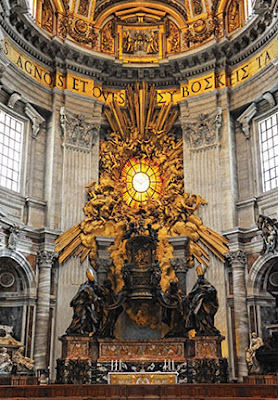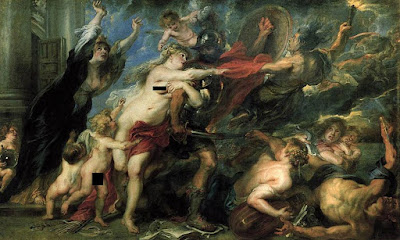google drive Art History AP notes
17th century italy & spain
-Political 17th century italy & spain
- division of nations
- elimination of city states
- got rid of Duchys, Republics, etc.
- extensive New World exploration (expansion, taking wealth):
Spain > Mexico, Philippines
France > Canada, Asia, Caribbean
England > Canada, Asia, Australia
Portugal > South America
Netherlands > Caribbean, South Africa
- France & England fighting over Canada
- Galileo + telescope
- Newton + microscope
- opera= union of music & theatre
- integration/fusion of architecture, sculpture, & painting (Bernini & st. peter's basilica)
counter reformation
council of trent (1563)the procrastination/denial of the catholic church in response to Protestantism was considered too little, too late [Martin Luther, 95 theses- 1517]-response of the catholic church in Europe:
- prohibition of nude images in religious art
- art must be accessible to the general public & easy to comprehend
- art should inspire the view to higher spiritual devotion
- renewed veneration of Saints in art
- megalomaniacal expansion of St. Peter's basilica
key artists:
ITALY
- gian lorenzo bernini
- borromini
- caravaggio de marisi
- artemesia gentileschi
- pietro da cortona
SPAIN
- zurbaran
- diego velazquez
10 characteristics of the baroque era:
- relative clarity of figures & narrative elements
- variable light intensity via tenebrism (extreme use of light & shadow) or a transcendent source
- inclusive subject matter that requires the viewer to complete the meaning
- compositional dynamism w emphatic diagonals & recessionals
- polychromatic colours imply vigor & excitement
- dramatic body language via gaze, gesture, or posture
- multiple points of view (various revelations)
- unity of form, theme, place (full integration of elements)
- open compositions considered to be extraverted spaces that invite the viewer & extend beyond borders
- abstract theme of the fusion of matter & spirit
Bernini:
figure 24-4
figure 24-5
figure 24-4
 |
| Saint Peter's (Piazza & colonnade)- Bernini break open the ovoid to welcome everyone, not just the erudite dramatic gesture of embrace |
 |
| Throne of Saint Peter- Bernini 1657-1666 solar disk dove in background |
 |
| Constantine- Bernini 1654-1670 Constantine on horseback w robe falling down moment of conversion/moment he converts to Christianity curtain behind him falls, representing his ignorance |
 |
| ecstasy of saint teresa- bernini |
 |
| apollo & daphne- bernini apollo wants the nymph daphne, she doesn't want him she ran away & the gods answered her prayers by turning her into a tree |
 |
| Blessed Ludovica Albertoni- Bernini 1671- 1674 drapery= struggle btwn body & spirit last breath before death momentum mori |
Fountains of Bernini in Rome (first to do sculptures in fountains):
-created aural sensation (see/hear water)
-created aural sensation (see/hear water)
 |
| Piazza Barberini |
 | ||
The Four Rivers
|
- expression of emotion in art: Alexander (Hellenistic) vs. Neptune (Baroque)
figure 24-9
figure 24-11
 |
| view of dome of san carlo alle quattro fontane- borromini rome, italy, 1638-1641
dome of heaven- max. light into dome through windows (interior)
coffered ceiling (interior)
|
Caravaggio:
-influenced by the vigor & dramatic moment depicted in Bernini's works of art
-focused on Naturalism w a hint of idealism
-oblique backgrounds
-tenebrism (stage lighting- often as diagonal shafts)
-humble humans (feet)
-golden glow/flush flesh
-genres: sacred/portrait/still life/genre
- tenebrism: exaggeration of light- chiaroscuro to max
figure 24-18
 |
inspiration of matthew- caravaggio
1603
hint of a halo
|
figure 24-18B
 |
| entombment of Christ- caravaggio stone corner coming out at you strong diagonal lines lead the eyes curves= recessionals= confines the shape man looking at you to draw you in & make you feel emotions |
 |
| doubting thomas- caravaggio focal point at hole diagonals & gaze point to it recessionals bring movement back repeating lines (wrinkles, hands, etc.) unify |
 |
| david- caravaggio david holding goliath's head (which was caravaggio's face) self immolation |
Diego Velazquez:
- bodegones: scenes of daily life with strong elements of still life in the composition
-elevates/honors status of "little people"= dwarfism
-"little people"= brought into court to teach children bc non-threatening & learned= au pair
figure 24-29
 |
| water carrier of seville- Velazquez |
 |
| don diego- Velazquez 1638 |
 |
| beggar- Velazquez 1642 |
figure 24-31
 |
| Venus & Mirror- Velazquez 1648 curtain= uncovering prostitute? blurry face in mirror similar to Venus of Urbino Venus & Cupid also in Bronzino's piece |
Baroque in Northern Europe (Flanders, Netherlands, France-17th c)
- more secular in the north
- higher level of realism- not ideal portrait
baroque characteristics:
- variable light
- compositional dynamism (diagonals, recessionals)
- extraversion- doesn't hide message, overt
- open composition
- crescendo moment
- dramatic body language
- implied movement (transformation)
key artists:
FLANDERS
- peter paul rubens
- rembrandt van rijn
- johannes vermeer
- pieter claesz
FRANCE
- nicolas poussin
- claude lorrain
- georges de la tour
- hyacinthe rigaud
Peter Paul Rubens
- specialty- depiction of human flesh
- vigorous movement & dynamic energy
- robust figures
- expressive faces
- writhing bodies
- implied circular motion
- dense narrative content
figure 25-2
 |
| the raising of the cross- rubens triptych 1610-11 variable light all gazes led to christ horse has piercing eyes |
figure 25-3
Rembrandt van Rijn
- known for feather in hat (from exotic birds) & beady eyes
- baroque exuberance w protestant conservatism
- beloved wife, Saskia (who died), included in several compositions
- transcendent illuminations in compositions
- optical clarity & precision
- opaque hue application
- crescendo moment narratives
- oil paintings of the old & new testament
- total financial bankruptcy in last decade of his life
- sterilization from surviving child
figure 25-12
 |
| the anatomy lesson of dr. tulp- rembrandt 1632 science & discovery of human anatomy/body |
figure 25-13
 |
| the night watch- rembrandt 1642 group of "good ol' boys" group portrait put his wife in the male-only portrait |
figure 25-15
 |
| self-portrait- rembrandt expressive face, revealing the soul controlled use of light nonspecific setting |
figure 25-15A
 |
| self-portrait- rembrandt 1658 psychology of light spiritual quality |
Johannes Vermeer
- optical clarity
- symbiosis of light & color
- meticulous detail
- serene interiors
- role of women
- genre/vedute
- 34 paintings in lifetime
- evidence of pin hole- difficulty w perspective
- secular subject matter
- experimentation w camera obscura
 |
| allegory of the art of painting- vermeer 1670-1675, oil on canvas |
figure 25-18C
 |
| the letter- vermeer highly idealized depictions of social values of the burghers |











No comments:
Post a Comment